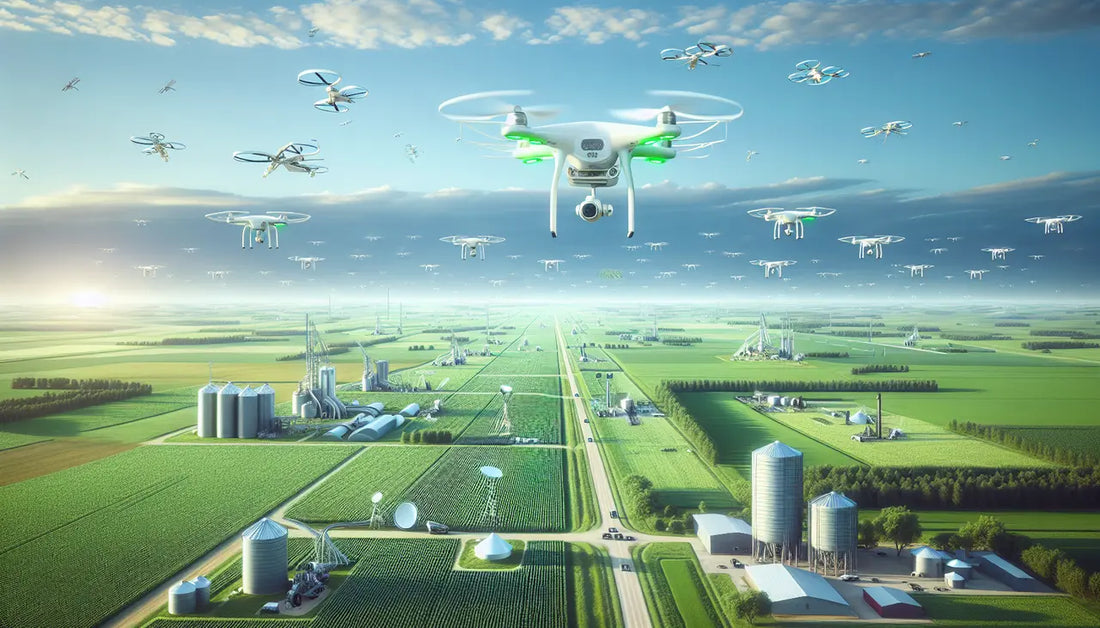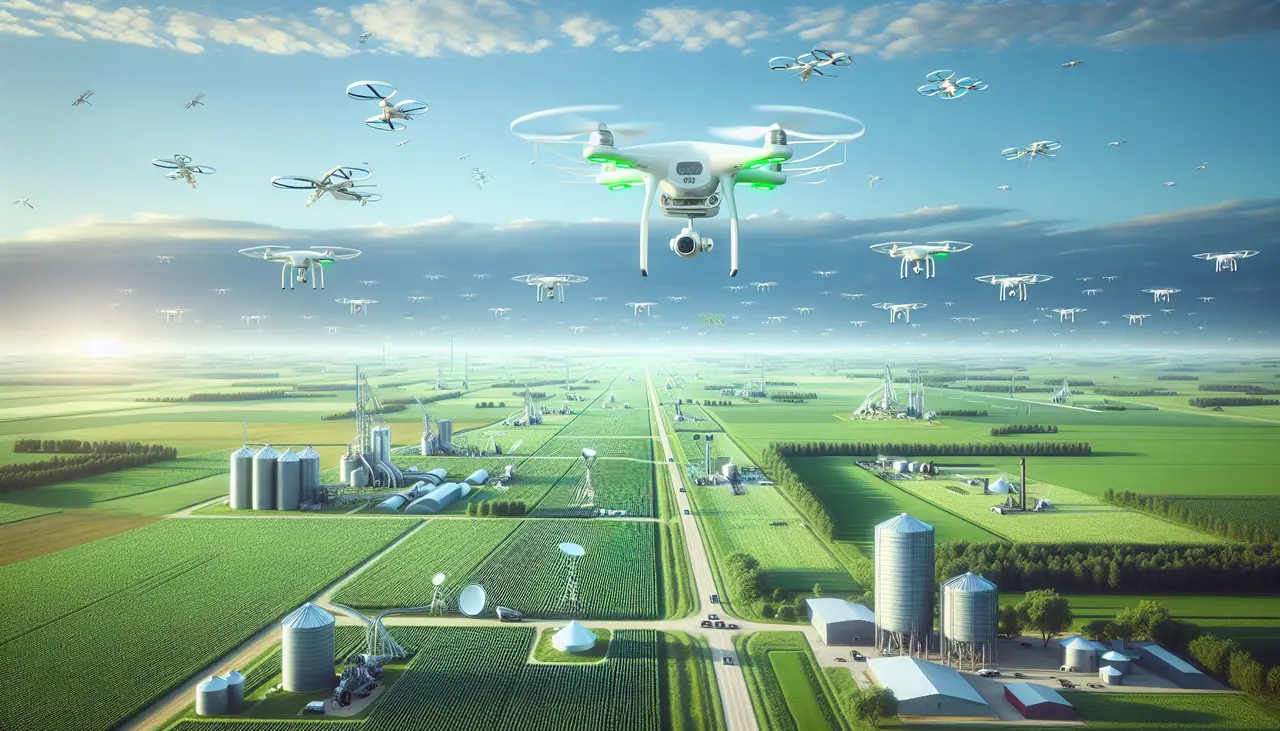
The Future of Farming in Huron, South Dakota: Embracing Agricultural Drones for Enhanced Efficiency
Share
Introduction to the Agricultural Revolution in Huron, South Dakota
Farming in Huron, South Dakota, is taking a giant leap into the future with the adoption of agricultural drones, marking the beginning of a new agricultural revolution. These cutting-edge tools are not just fancy gadgets flying around; they’re powerful allies in boosting efficiency on the farm. By using drones, farmers in Huron are able to monitor crop health, manage resources more effectively, and ultimately increase yields without the backbreaking labor traditionally associated with farming. This shift towards technology is transforming the landscape of agriculture in Huron, making it a beacon of innovation in the farming world. The adoption of drones sets Huron’s farmers apart, showcasing a commitment to leveraging technology for sustainable growth and efficiency. As we delve deeper, let’s uncover how these drones are changing the game in Huron, pushing the boundaries of what’s possible in agriculture.
The Emerging Role of Agricultural Drones in Modern Farming
Drones are changing the game in farming, especially in places like Huron, South Dakota. Think about it. These high-flying gadgets aren’t just for stunning aerial photos anymore. They’re now vital tools in a farmer’s toolbox, helping keep crops healthy and boosting yields. How? By offering a bird’s eye view to monitor crop health, moisture levels, and even pest issues. Plus, they make it easier to apply fertilizers and pesticides right where they’re needed, cutting down on waste and costs. It’s about doing more with less, making farming not just more efficient but also more sustainable. So, when you hear about drones buzzing over fields in Huron, remember, it’s the sound of farming stepping into the future.
Benefits of Integrating Agricultural Drones into Farming Practices
Agricultural drones are changing the game in Huron, South Dakota, offering a bunch of benefits that traditional farming methods just can’t match. First off, these flying helpers save a ton of time. Picture scanning vast fields in minutes, not hours or days, to check on crop health. That’s what drones do. They give farmers the power to see more in less time, helping them make quicker, smarter decisions about their land.
Next up, they’re precision wizards. Drones can drop seeds or spray fertilizer and pesticides in exact spots. This means less waste and more savings for the farmers since they’re only using what they need, where they need it. Plus, this approach is kinder to the environment.
The big kicker? Healthier crops. Drones can spot sick plants early on by using special cameras that see details our eyes can’t. Catching problems early means less damage and higher yields come harvest time.
In a nutshell, by embracing drone technology, farmers in Huron are looking at bigger profits, healthier fields, and a smarter way to farm. Who knew something from the sky could keep things green on the ground?
How Agricultural Drones are Changing the Farming Landscape in Huron
Agricultural drones are revolutionizing how farmers in Huron manage their crops and livestock. These high-flying tools offer a bird’s eye view of large areas, making it easier to monitor plant health, track cattle, and even apply fertilizers or pesticides directly where needed. Here’s the lowdown: these drones can scan a field for crop health, identifying areas that need attention. That means less time walking the fields and more time solving problems. They help in detecting pests, diseases, and poor nutrition spots. Plus, they’re not just about spotting trouble. Drones can carry small payloads to treat specific areas, making them efficient for precision farming. It’s a game changer, leading to healthier crops, higher yields, and more efficient use of resources like water and chemicals. In essence, drones are shaping the future of farming in Huron by making it smarter, more efficient, and sustainable.
Key Features of Agricultural Drones for Enhanced Farming Efficiency
Agricultural drones are changing the game in Huron, South Dakota, and here’s how they’re doing it. These high-tech helpers come equipped with features designed to boost farming efficiency. First off, they’ve got imaging tech that allows farmers to see their fields in a whole new way. This includes thermal imaging to check on plant health and multispectral imaging to monitor crop growth. Pretty neat, right?
Then, there’s the precision aspect. Drones can target specific areas for treatment, meaning less waste of materials like pesticides and fertilizers. This is not only good for the farmer’s wallet but also for the environment.
These drones are also champions of data collection. They gather tons of useful information that can help in making smarter farming decisions. Imagine knowing exactly when to water or harvest, all thanks to the data from your drone.
Lastly, drones are all about saving time. They can cover large areas of land much faster than traditional methods. For a farmer, time saved is money earned.
So, to sum it up, agricultural drones in Huron are offering imaging technology, precision treatment, extensive data collection, and time-saving benefits. With these features, it’s clear they’re a powerful tool for making farming more efficient.
Case Studies: Successful Use of Agricultural Drones in Huron Farms
Farmers in Huron, South Dakota, have turned to agricultural drones, showcasing significant advancements in farming efficiency and production. One standout case is a wheat farmer who integrated drone technology for crop monitoring and reported a 20% increase in yield. Drones equipped with high-resolution cameras and sensors helped pinpoint stress areas in crops early, allowing for timely interventions. Another example is a soybean farm that used drones for precise pesticide application. This reduced chemical usage by 30% and lowered costs, proving environmental and economic benefits. Similarly, a corn producer employed drones for mapping out planting patterns, leading to optimized field use and enhanced crop health. These cases highlight drones’ pivotal role in transforming farming practices in Huron, making agriculture more sustainable and productive.
Challenges and Considerations in Adopting Agricultural Drones
When it comes to adopting agricultural drones in Huron, South Dakota, farmers face a few hurdles and things to think about. First off, the cost can be high. Getting a drone up and running on a farm isn’t cheap, and the price tag might scare some folks away. Then there’s the learning curve. Not everyone knows how to pilot these high-tech helpers or read the data they collect. It’s like learning a whole new language for some.
Also, privacy and safety are big deals. When drones are zipping around, there’s always a concern about them crashing or taking pictures where they shouldn’t. Lastly, there are rules to follow. The government has a say in where and how you can fly drones, which can be a bit of a headache to keep straight.
Despite these challenges, the benefits of drone technology in farming—like better crop monitoring and more efficient use of resources—are pushing many in Huron to consider taking the leap. They just have to weigh the costs and benefits carefully.
The Environmental Impact of Using Agricultural Drones in Farming
Drones are changing the game in farming, especially when it comes to the environment. By using drones, farmers in Huron can keep a closer eye on their crops without stepping foot in the field. This means less driving around in trucks or tractors, leading to fewer carbon emissions. It’s a win for the planet. Also, these flying helpers are precise. They can spot which parts of a field need more water or fertilizer. This precision cuts down on waste. Less fertilizer runoff means healthier rivers and lakes. Plus, with drones, farmers can easily monitor crop health. Sick plants get treated fast, stopping disease spread. Healthy plants mean less need for chemical sprays. In short, drones in farming help the land we love stay green and clean while keeping our crops healthy.
Future Trends: The Expanding Horizons of Agricultural Drones in Agriculture
Drones are changing farming in big ways in places like Huron, South Dakota. Think of drones as your high-flying helpers that can do a lot without getting tired. Farmers are using drones to check on crops, take pictures from the sky, and even spray fertilizers or water. The cool part? Drones can go places tractors can’t, like over wet fields after a big rain without getting stuck.
Here’s the kicker: this isn’t just about taking a peek at your corn from the sky. Drones collect data — a lot of it. They can tell a farmer exactly where a crop might be sick way before it looks sick to the human eye. This means farmers can act fast, saving crops and money. It’s like having super-vision for farming.
As more farmers start using drones, we’re expecting to see a few big trends. Prices for drones might go down, making them more affordable for small and medium farms. Better drones with cooler features like longer flight times and more detailed cameras will likely come out. We’re also thinking there will be more support, like people you can call when you can’t figure out how to get your drone to do what you want.
In short, drones in agriculture are like opening a new chapter in farming. They’re not just flying cameras; they’re tools that can make a huge difference in how efficiently a farm runs. For places like Huron, South Dakota, and beyond, the sky’s the limit.
Conclusion: The Transformative Potential of Agricultural Drones in Huron’s Farming Industry
Agricultural drones have changed the game in Huron, South Dakota. These high-flying tools can scan acres in minutes, something that used to take hours or days. Farmers can now pinpoint where their fields need water, fertilizer, or pest control, saving time and money. It’s not just about doing things faster; it’s about doing them smarter. The data collected by drones can help farmers make informed decisions, leading to higher yields and less waste. This is a big deal in a place where farming isn’t just a job—it’s a way of life. The investment might seem a bit steep at first, but the long-term benefits are clear. With drones, Huron’s farmers are not just keeping up; they’re staying ahead. As we look to the future, it’s clear that agricultural drones aren’t just a temporary trend. They’re a tool that’s reshaping the landscape of farming in Huron. In embracing this technology, Huron positions itself at the forefront of modern agriculture.

